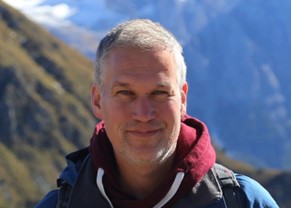Meet the Pollinator Expert: Axel Hochkirch
In this edition of “Meet the Expert”, we introduce Prof. Dr. Axel Hochkirch, Chair of the IUCN SSC Invertebrate Conservation Committee and associate professor in the Biogeography department at Trier University in Germany.

Photo: Axel Hochkirch
This is the second interview of experts who are involved in the development of Species Action Plans for EU Pollinators. The goal of this project is to create three conservation action plans for threatened pollinator species in the EU. To this end, IUCN collaborates with specialists from the IUCN Species Survival Commission, in particular from the Invertebrate Conservation Committee and the Hoverfly Specialist Group, as well as Buglife.
Conservation action plans are crucial tools for the conservation of highly threatened species that clearly define the actions that have to be undertaken. Without such action plans, many neglected species would not be considered for conservation and may go extinct. The IUCN Guidelines for Species Conservation Planning provide the conceptional background leading to successful planning, but engaged practitioners on the ground that can implement the action plan are indispensable.
Axel Hochkirch’s work with IUCN dates back to 2009, when he identified the need for increased representation of Orthoptera species in the IUCN Red List. With support from the IUCN SSC Invertebrate Conservation Sub-Committee, Axel helped establish the IUCN SSC Grasshopper Specialist Group. Since 2013, Axel has chaired the IUCN SSC Invertebrate Conservation Committee, and he has also supported IUCN in the development of the standards for Key Biodiversity Areas and Green Status assessments and helped form new specialist groups for invertebrates. With his longstanding experience in conservation and invertebrate biology, Axel is a key contributor to the development of Species Action Plans for EU Pollinators. He currently works as a scientific lab manager and associate professor in the Biogeography department at Trier University in Germany, where he teaches conservation biology, population genetics, molecular biogeography, and insect taxonomy since 2008. Next year, he will join the Natural History Museum in Luxembourg as a curator for ecology.
Axel knew that he wanted to become a conservation biologist from a young age. At only 14 years old, he joined several conservation NGOs and at 16, he became Secretary of the county section of BUND – the German “Friends of the Earth”. Before university, Axel worked as a civil servant, where he engaged in peat bog conservation, learning about habitat management and species monitoring, and helping restore a diversity of degraded habitats. At this time, Axel also specialized on Orthoptera (grasshoppers, crickets, and bush-crickets) and wrote a conservation action plan for the Field Cricket (Gryllus campestris), which is Critically Endangered in northern Germany.
At University, Axel studied Biology and continued to be engaged in habitat conservation. He actively monitored the Field Cricket population and helped with the management of its habitats, while writing his first publications on Orthoptera conservation. Throughout the years, he also worked as an ecological consultant and surveyed a variety of other animals including birds, amphibians, and butterflies.
Axel is fascinated by all kinds of biodiversity, but has a passion for the “forgotten species”, especially those with unique life histories or symbioses, such as fig wasps, which spend their larval stage inside figs to later become essential pollinators of the plant.
Today, general knowledge of pollinators is increasing, but still limited. Many people are not aware that flies, beetles, bush crickets, and even ants can be important pollinators. Axel highlights how diverse pollinators are, but also that our knowledge of many species is scarce, as approximately 80% of all insects are not even named. “We also have limited knowledge of the distribution, ecology, and threats of the described species”, he says. Knowledge and awareness, however, are essential to ensure successful conservation practices .
Axel’s greatest concern about the future of Europe’s pollinators is the continuous loss of land use diversity. Caused by agricultural intensification and abandonment, this trend leads to the depletion of habitats, plants, and, consequently, pollinators. “Furthermore”, Axel says, “the industry keeps on inventing new pesticides and we have only limited knowledge about the long-term effects of new substances on insect assemblages”.
Nevertheless, Axel is hopeful that regional conservation planning and zero-extinction targets will have a positive impact on the future of European pollinators. He also encourages supporting pollinators in our gardens. “Most pollinators do not need a lot of space, but they need native food plants and structures to feed their larvae. Many wild bee species, for example, need patches of bare ground or dead wood for breeding, but they also need specific food plants to collect pollen to feed their larvae. Old cottage gardens or orchards can provide such structures (e.g. with apple- and olive trees).” In addition, Axel emphasizes that as consumers, we can promote pollinator-friendly farming by buying organic food and supporting local traditional farms.
To learn more about the joint efforts of IUCN and its partners in the development of Specias Action Plans for EU Pollinators check out the dedicated page on the European Commission website and this IUCN web story.
For further information about the project, please contact Dr. Aurore Trottet at aurore.trottet@iucn.org.
We are here to share current happenings in the bee industry. Bee Culture gathers and shares articles published by outside sources. For more information about this specific article, please visit the original publish source: Meet the Pollinator Expert: Axel Hochkirch – Story | IUCN






